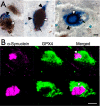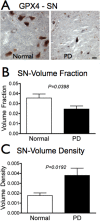Glutathione Peroxidase 4 is associated with Neuromelanin in Substantia Nigra and Dystrophic Axons in Putamen of Parkinson's brain
- PMID: 21255396
- PMCID: PMC3037910
- DOI: 10.1186/1750-1326-6-8
Glutathione Peroxidase 4 is associated with Neuromelanin in Substantia Nigra and Dystrophic Axons in Putamen of Parkinson's brain
Abstract
Background: Parkinson's disease is a neurodegenerative disorder characterized pathologically by the loss of nigrostriatal dopamine neurons that project from the substantia nigra in the midbrain to the putamen and caudate nuclei, leading to the clinical features of bradykinesia, rigidity, and rest tremor. Oxidative stress from oxidized dopamine and related compounds may contribute to the degeneration characteristic of this disease.
Results: To investigate a possible role of the phospholipid hydroperoxidase glutathione peroxidase 4 (GPX4) in protection from oxidative stress, we investigated GPX4 expression in postmortem human brain tissue from individuals with and without Parkinson's disease. In both control and Parkinson's samples, GPX4 was found in dopaminergic nigral neurons colocalized with neuromelanin. Overall GPX4 was significantly reduced in substantia nigra in Parkinson's vs. control subjects, but was increased relative to the cell density of surviving nigral cells. In putamen, GPX4 was concentrated within dystrophic dopaminergic axons in Parkinson's subjects, although overall levels of GPX4 were not significantly different compared to control putamen.
Conclusions: This study demonstrates an up-regulation of GPX4 in neurons of substantia nigra and association of this protein with dystrophic axons in striatum of Parkinson's brain, indicating a possible neuroprotective role. Additionally, our findings suggest this enzyme may contribute to the production of neuromelanin.
Figures







References
-
- Adams JD Jr, Chang ML, Klaidman L. Parkinson's disease--redox mechanisms. Curr Med Chem. 2001;8:809–814. - PubMed
-
- De Iuliis A, Burlina AP, Boschetto R, Zambenedetti P, Arslan P, Galzigna L. Increased dopamine peroxidation in postmortem Parkinsonian brain. Biochim Biophys Acta. 2002;1573:63–67. - PubMed
LinkOut - more resources
Full Text Sources

